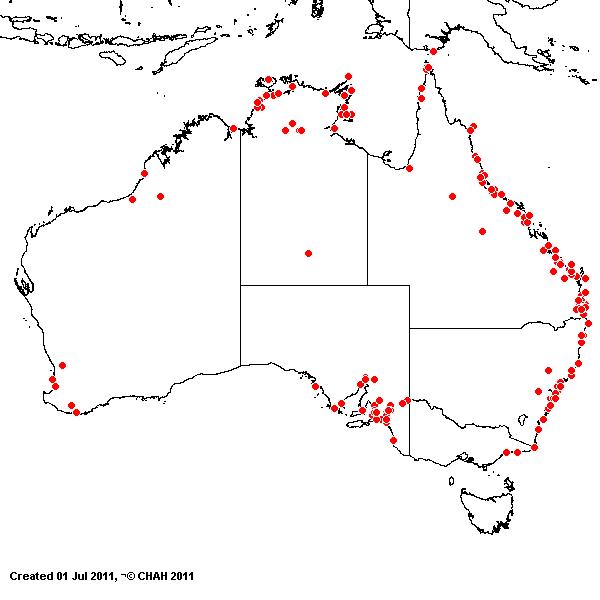Paspalum vaginatum* Sw. Prodr. Veg.
Ind. Occ. 21 (1788).
Classification. (GPWG 2001) : Subfamily
Panicoideae. Paniceae.
Type of Basionym or
Protologue Information: Jamaica, O.P. Swartz s.n. (HT: S; IT: US).
Recent synonyms:
P. distichum auct.
Key references
(books and floras): [1810]. R.Brown, Prodromus (188 as Paspalum
littorale), [1952] C.A.Gardner, Flora of Western Australia 1 Gramineae
(241), [2002] D.Sharp & B.K.Simon, AusGrass, Grasses of Australia,
[2002] J.Wheeler, N.Marchant & M.Lewington, Flora of the South West (425),
[2006] J.Jessop, G.R.M.Dashorst, F.M.James, Grasses of South Australia
(470), [2008] S.W.L.Jacobs, R.D.B.Walley & D.J.B.Wheeler, Grasses of New
South Wales (331).
Illustrations:
[2006] J.Jessop, G.R.M.Dashorst, F.M.James, Grasses of South Australia (470, Fig. 403), [2008] S.W.L.Jacobs,
R.D.B.Whalley & D.J.B.Wheeler, Grasses of New South Wales, 4th edn
(331).
Habit.
Perennial. Rhizomes present. Stolons present. Culms erect or decumbent, 8–60 cm
tall, 5–13 -noded. Mid-culm nodes glabrous. Lateral branches sparsely branched.
Leaf-sheaths glabrous on surface. Leaf-sheath auricles absent. Ligule an
eciliate membrane, 0.5–1.2 mm long. Leaf-blades flat or convolute, 2.5–22 cm
long, 1–8 mm wide. Leaf-blade surface smooth, glabrous.
Inflorescence.
Inflorescence digitate, a panicle of racemes. Racemes 2(–5), spreading, 1.5–7.5
cm long, 1.5–3.5 mm wide, bearing 16–32 fertile spikelets on each. Central
inflorescence axis 0–1.2 cm long.
Spikelets.
Spikelets sessile. Fertile spikelets 2-flowered, the lower floret barren
(rarely male), the upper fertile, comprising 1 basal sterile florets,
comprising 1 fertile floret(s), without rachilla extension, elliptic or ovate,
dorsally compressed, 2.5–4.5 mm long.
Glumes. Glumes
thinner than fertile lemma. Lower glume when present ovate, hyaline, 0 -nerved.
Upper glume elliptic, 2.5–3.7 mm long, membranous, without keels, 2–6 -nerved.
Upper glume surface glabrous. Florets. Basal sterile florets 1, barren,
without significant palea. Lemma of lower sterile floret 100 % of length of
spikelet, membranous, 2–5 -nerved.
Fertile lemma 2.3–2.5
mm long, without keel.
Continental
Distribution: Europe, Africa, Temperate Asia, Tropical Asia, Australasia,
Pacific, North America, and South America.
Australian
Distribution: Western Australia, Northern Territory, South Australia,
Queensland, New South Wales, Victoria, Lord Howe, Cocos Keeling Is, Ashmore
Reef, Coral Sea Is.
Western Australia:
Dampier. Drummond. Northern Territory: Darwin & Gulf. South Australia:
Eyre Peninsula, Murray, Yorke Peninsula, Southern Lofty, South-eastern. Queensland:
Cook, Port Curtis, South Kennedy, Burke, North Kennedy, Burnett, Wide Bay,
Moreton. New South Wales: North Coast, Central Coast, South Coast. Victoria:
East Gippsland, Gippsland Plain.
Notes. The
nomenclatural confusion among P. distichum, P. papsaloides and P.
vaginatum was resolved in Taxon (1983). An aquatic weed and fodder plant of
brackish or saline chiefly coastal habitats. Readily eaten by cattle, possibly
of some nutritional value as a fodder on swampy, saline soils.
Introduced. In
tropical heaths, tropical and subtropical rain forests, tropical and
subtropical wet sclerophyll forests, dry sclerophyll forests, tropical and
subtropical sub-humid woodlands, semi-arid shrub woodlands, and acacia
shrublands. Well-established in Australia but of limited economic importance.
Flowers sporadically throughout the year.





